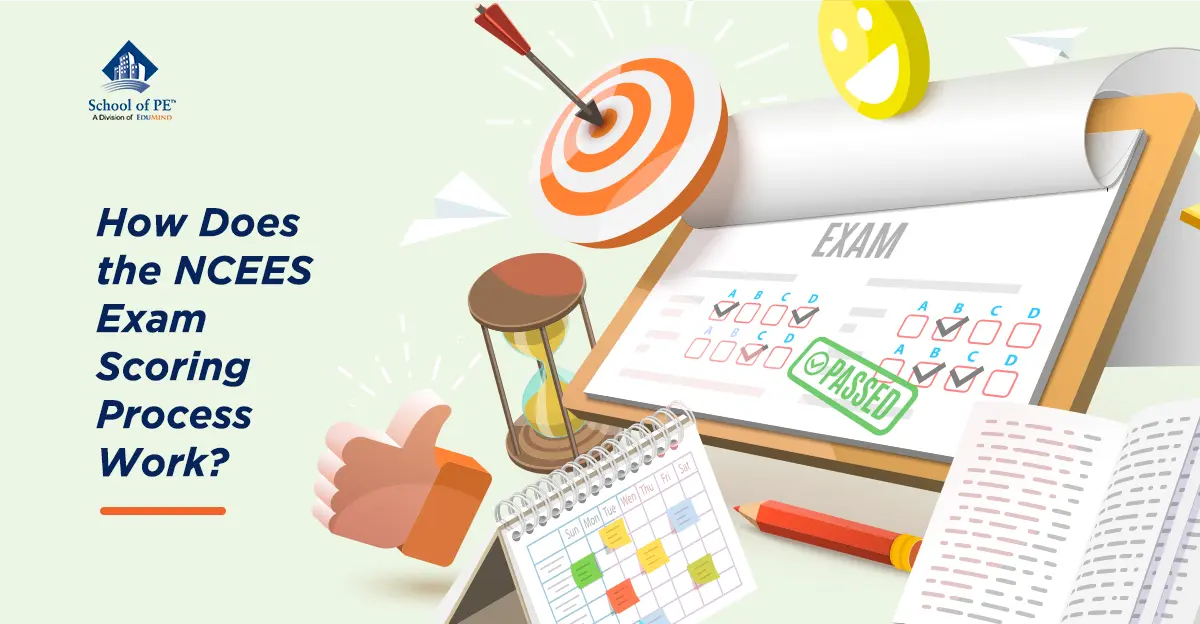NCEES Exam Scoring
The National Council of Examiners for Engineering and Surveying (NCEES) exam scoring process is not overly complex; like most exams, the key idea is that the more questions you answer correctly, the higher your probability of achieving a passing result! During the exam, this is all you need to worry about, since you, of course, cannot challenge questions to your proctor in the exam room. There are two exam types: computer-based testing (CBT) and pencil-and-paper. Historically, the exams were pencil-and-paper with the scantron sheet, and this was how I took both the Fundamentals of Engineering (FE) and Principles and Practice of Engineering (PE) exams. Over the past few years, NCEES has been transitioning the exam format from pencil-and-paper to CBT as examination administration goes forward.
CBT Grading
CBT grading is based on the total number of correct answers, with no deductions for wrong answers. I found this to be easier than the Scholastic Aptitude Test (SAT) in high school since the SAT offered the option of leaving answers blank where you had to be more strategic about omitting certain questions to better preserve your score. You should answer ALL questions for both FE and PE exams, even if you must blindly guess without having the time to properly attempt a solution. NCEES does not award partial credit or dock points for showing your work (right or wrong); the exam scoring process only considers your actual multiple-choice answer. While in grad school, I encountered a similar situation with an accidental correct answer. My professor explained that I solved the question incorrectly and that the fact I still came to the correct answer was pure luck, but I was still awarded the points! So, you can still solve for the correct answer despite incomplete computations!
FE vs. PE Exams
Both the FE and PE exams for CBT are graded using the same format. All exams are scored first, then NCEES determines the Pass/Fail borderline (cut score); scoring at or above the cut score is passing, and scoring below produces a failing result. The raw score is converted to a scaled score, adjusting for differences in difficulty across the different exams. NCEES does not release exam scores, nor do they pre-determine a PE exam or FE exam passing score or passing percentage. However, for the PE Mechanical exam, it is generally believed that the cut score is around 70% (56 out of 80 multiple choice questions). If you fail the exam, you will receive a diagnostic report identifying areas of deficiency so you can improve and refocus for retaking the exam. If you pass the exam, there is no diagnostic report as a passing FE exam score or passing PE exam score indicates that you are generally proficient in all examination subject areas.
All Exams Are Scored the Same Way
First-time takers and repeat takers are graded to the same standard; NCEES does not discriminate whether this is your first exam or 20th exam! All exams are scored the same way, regardless of discipline (e.g., Mechanical, Civil, Electrical, etc.). CBT exam results are generally available 7-10 days after taking the exam nowadays. When I took the FE and PE exams, the wait period was much longer (but at least you could enjoy the anticipation!). Once scores are available, NCEES will provide a notification with further instructions to review your exam score and the next steps, whether that be for receiving your Engineer-in-Training (EIT) designation, professional licensure information, or information on retaking the exam.
The Transition from Pencil-and-Paper to Computer-Based Testing
NCEES is currently transitioning its examination administration format from pencil-and-paper to CBT. The NCEES FE Reference Handbook does not distinguish by engineering discipline; all modules are now fully CBT format. In the past few years, many PE exams have switched to the CBT format, but as of this blog post, the pencil-and-paper format is still in effect for the PE Structural engineering exam. I had taken the pencil-and-paper exam for both FE and PE exams, and NCEES will release those results to the respective state boards in about 8-10 weeks after the exam date. States have different ways of notifying examinees. I received my FE pass exam result from Professional Credential Services (PCS). Some state boards will release the results themselves to examinees while other state boards will utilize NCEES Exam Administration Services to notify examinees. Some state boards will also validate results at a board meeting to ensure agreement on the passing cut score and resolve any discrepancies before releasing results.
Pencil-and-Paper Grading
All multiple-choice exams for pencil-and-paper are machine-graded, with some scantron sheets manually checked to verify the machine process. I had a high school teacher who explained that the machine-grading was flawed while he was in grade school; you could simply fill in all answers on the scantron sheet to achieve the correct answer (back then, the machine-grading early on was unable to detect multiple answers filled-in for the same question!). Specifications can change for a particular exam; based on my own studying of past practice exams, I would say the topics and questions are adjusted approximately every five years. NCEES conducts a content review of each exam every 6-8 years. This also serves as a check and balance to ensure the content is fair and appropriate as exams are administered each year. Engineering is a dynamic industry, so you can expect change throughout your career due to economic, technological, and even political factors. If you have not taken the exam in a while, you will probably need to start fresh with your studying content and references.
PE Structural Exam
For the PE Structural exam (pencil-and-paper), the afternoon session contains essay items. The essays are graded by SMEs using a mutual scoring plan to avoid subjective opinions. Two experts will complete the essay scoring with a third expert available if necessary. Minimum competency is evaluated based on combined performance of both morning and afternoon sessions.
Changes Since I Took the Exam
I passed the FE exam in October 2013, and the examination format has changed over the past 8-9 years. I registered for the FE Chemical exam where the morning session was focused on general engineering, and the afternoon session was more geared towards the chemical discipline. But my understanding now is that both morning and afternoon sessions are more relevant towards your chosen discipline (this is good because I struggled with moment of inertia during the morning session!). My FE Chemical exam was 8 hours and 180 Questions total (120 morning, 60 afternoon), but now the FE Chemical is just 110 Questions in 6 hours. When exam topics do change, a committee of Subject Matter Experts (SMEs) collaborate with statisticians to determine appropriate evaluation of comprehension for a particular subject. The PE exam first began in the 1960s and has undergone numerous changes since its inception. This reflects different testing formats as well as the evolution of the engineering industry over time.
Outlying Questions Will Be Pulled from the Queue
Some questions with unusual statistics can be flagged for further review. For example, if one question saw examinees with an overwhelming number of wrong answers, that question may be deemed inappropriate and removed from scoring consideration. It is not uncommon for examinees to challenge certain questions with comments after the examination; if further review reveals an error in a particular question, credit may be awarded for more than just the original correct answer. Keep this mind during the exam: you should not get discouraged if you are struggling with a few questions. Chances are that others are also struggling with those same questions! Remember too, the NCEES Examinee Guide is continuously updated; the most recent version is as of March 1, 2022, so be sure to keep checking for any examination updates - I am refreshing myself while writing this blog post!
Conclusion
The scoring process involves extensive statistical analysis to ensure adequate performance so individuals are ready for the next steps of the engineering profession, whether it be as an Engineer-In-Training or as a Professional Engineer. The process also upholds professional standards with an equal grading system across all engineering disciplines. You can also refer to the NCEES website for more information on the exam scoring process and official NCEES Examinee Guide. School of PE aligns itself with NCEES standards, so I would recommend checking both School of PE and NCEES frequently for the most recent updates on examination policy and procedures.
Consider partnering with School of PE to boost your chances of receiving a passing score on your NCEES exam! We offer exam prep courses in numerous engineering disciplines - register today!
About the Author: Gregory Nicosia
Gregory Nicosia, PE is an engineer who has been practicing in the industry for eight years. His background includes natural gas, utilities, mechanical, and civil engineering. He earned his chemical engineering undergraduate degree at Drexel University (2014) and master's in business administration (MBA) from Penn State Harrisburg (2018). He received his EIT designation in 2014 and PE license in 2018. Mr. Nicosia firmly believes in continuing to grow his skillset to become a more well-rounded engineer and adapt to an ever-changing world.



